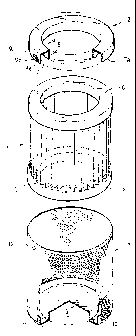Some of the information on this Web page has been provided by external sources. The Government of Canada is not responsible for the accuracy, reliability or currency of the information supplied by external sources. Users wishing to rely upon this information should consult directly with the source of the information. Content provided by external sources is not subject to official languages, privacy and accessibility requirements.
Any discrepancies in the text and image of the Claims and Abstract are due to differing posting times. Text of the Claims and Abstract are posted:
| (12) Patent: | (11) CA 2237959 |
|---|---|
| (54) English Title: | A FILTER ELEMENT FOR A FLUID FILTER |
| (54) French Title: | ELEMENT DE FILTRE POUR FILTRE A FLUIDE |
| Status: | Term Expired - Post Grant Beyond Limit |
| (51) International Patent Classification (IPC): |
|
|---|---|
| (72) Inventors : |
|
| (73) Owners : |
|
| (71) Applicants : |
|
| (74) Agent: | SMART & BIGGAR LP |
| (74) Associate agent: | |
| (45) Issued: | 2004-12-14 |
| (86) PCT Filing Date: | 1996-11-15 |
| (87) Open to Public Inspection: | 1997-06-19 |
| Examination requested: | 2001-01-31 |
| Availability of licence: | N/A |
| Dedicated to the Public: | N/A |
| (25) Language of filing: | English |
| Patent Cooperation Treaty (PCT): | Yes |
|---|---|
| (86) PCT Filing Number: | PCT/NL1996/000453 |
| (87) International Publication Number: | WO 1997021480 |
| (85) National Entry: | 1998-05-15 |
| (30) Application Priority Data: | ||||||
|---|---|---|---|---|---|---|
|
The invention relates to a filter element (1) for a fluid filter, comprising a
web of
pleated filtering material that is formed into a circumferentially closed
cylindrical filter body,
which is coaxially supported by a perforate rigid tube (4) and the axial ends
of which are
sealingly inserted into corresponding annular receiving cavities provided in a
rigid bottom
end cap (3) at one end and in a rigid annular end cap (2) at the opposite end
of the filter
body. According to the invention the cylindrical filter body has its terminal
edges {5)
embedded in separate sealing rings (6) of a flexible type of rubber or similar
elastomeric
material and that said filter body is sealingly clamped with said sealing
rings, and together
with the said spporting tube, removably between the rigid bottom end cap and
annular end
cap respectively.
L'invention porte sur un élément de filtre (1) pour filtre à fluide, comportant une bande de matériau filtrant froncée, transformée en un corps de filtre cylindrique fermé, soutenu coaxialement par un tube rigide perforé (4) et dont les extrémités axiales sont hermétiquement insérées dans des cavités annulaires correspondantes de logement ménagées dans un couvercle inférieur rigide terminal (3) au niveau d'une des extrémités du corps de filtre ainsi que dans un couvercle annulaire rigide terminal (2) au niveau de l'extrémité opposée. Selon l'invention, les bords terminaux (5) du corps cylindrique du filtre sont pris dans des anneaux d'étanchéité (6), séparés, en caoutchouc de type souple ou faits d'un élastomère analogue, et le corps de filtre, qui vient s'emboîter hermétiquement dans les anneaux d'étanchéité, est monté de manière amovible, avec le tube de support, entre le couvercle inférieur rigide et le couvercle annulaire d'extrémité, respectivement.
Note: Claims are shown in the official language in which they were submitted.
Note: Descriptions are shown in the official language in which they were submitted.

2024-08-01:As part of the Next Generation Patents (NGP) transition, the Canadian Patents Database (CPD) now contains a more detailed Event History, which replicates the Event Log of our new back-office solution.
Please note that "Inactive:" events refers to events no longer in use in our new back-office solution.
For a clearer understanding of the status of the application/patent presented on this page, the site Disclaimer , as well as the definitions for Patent , Event History , Maintenance Fee and Payment History should be consulted.
| Description | Date |
|---|---|
| Inactive: Expired (new Act pat) | 2016-11-15 |
| Inactive: IPC from MCD | 2006-03-12 |
| Grant by Issuance | 2004-12-14 |
| Inactive: Cover page published | 2004-12-13 |
| Inactive: Final fee received | 2004-09-29 |
| Pre-grant | 2004-09-29 |
| Notice of Allowance is Issued | 2004-04-14 |
| Letter Sent | 2004-04-14 |
| Notice of Allowance is Issued | 2004-04-14 |
| Inactive: Approved for allowance (AFA) | 2004-03-25 |
| Amendment Received - Voluntary Amendment | 2004-02-11 |
| Inactive: IPC assigned | 2003-08-22 |
| Inactive: IPC assigned | 2003-08-22 |
| Inactive: S.30(2) Rules - Examiner requisition | 2003-08-11 |
| Amendment Received - Voluntary Amendment | 2001-04-26 |
| Amendment Received - Voluntary Amendment | 2001-03-30 |
| Letter Sent | 2001-02-26 |
| All Requirements for Examination Determined Compliant | 2001-01-31 |
| Request for Examination Requirements Determined Compliant | 2001-01-31 |
| Request for Examination Received | 2001-01-31 |
| Inactive: First IPC assigned | 1998-09-10 |
| Inactive: IPC assigned | 1998-09-10 |
| Classification Modified | 1998-09-10 |
| Inactive: Notice - National entry - No RFE | 1998-07-31 |
| Application Received - PCT | 1998-07-29 |
| Application Published (Open to Public Inspection) | 1997-06-19 |
There is no abandonment history.
The last payment was received on 2004-09-22
Note : If the full payment has not been received on or before the date indicated, a further fee may be required which may be one of the following
Please refer to the CIPO Patent Fees web page to see all current fee amounts.
Note: Records showing the ownership history in alphabetical order.
| Current Owners on Record |
|---|
| FAIREY ARLON B.V. |
| Past Owners on Record |
|---|
| ANTONIUS JOSEPHUS BARTELS |